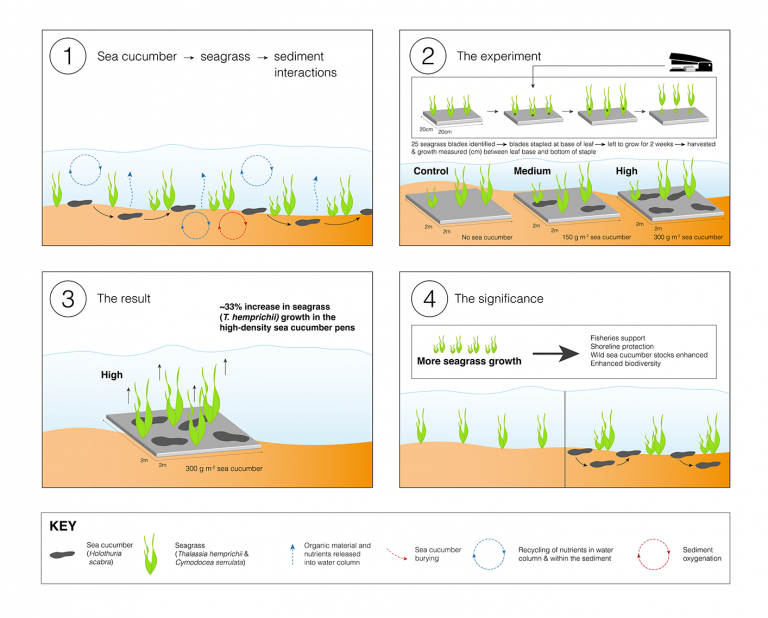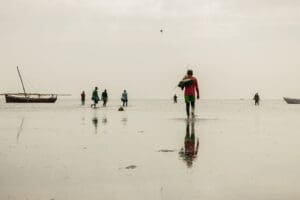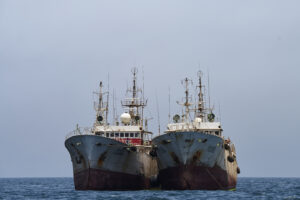New research published this week in Aquaculture Environmental Interactions has found that sea cucumber aquaculture can positively impact seagrass meadows, increasing the growth rate of certain species. This work, led by researchers at the University of Edinburgh in collaboration with Blue Ventures, presents the first evidence of community-based sea cucumber farming benefiting a marine ecosystem.
Seagrass meadows are globally important coastal habitats that provide a wealth of ecosystem services. They stabilise shorelines, harbour high biodiversity including many endangered and threatened species, and provide a nursery ground for commercially and ecologically important fish species. As such, they form the basis of the world’s primary fishing grounds, underpinning as much as one fifth of the world’s fisheries.
Sea cucumbers are widespread marine animals that inhabit a range of seabed habitats from the deep sea to coastal areas. One of the most valuable of these species – Holothuria scabra – inhabits shallow coastal waters and is commonly found in seagrass beds throughout the tropical Indo-Pacific. For centuries they have been harvested by coastal communities to supply Asian seafood markets, primarily as a luxury dried food item known as ‘beche-de-mer’ and ‘trepang’. However, since the 1980s, overexploitation has devastated wild populations. In response, communities in Madagascar began to farm sea cucumbers in 2009, working in partnership with Blue Ventures and local aquaculture business Indian Ocean Trepang (IOT). Over recent years locally run sea cucumber farms have grown in size and profitability within Locally Managed Marine Areas (LMMAs) in the southwest of Madagascar, providing important new income for communities who rely heavily on the ocean for survival. Farms are generally located within shallow, sheltered seagrass lagoons, a favoured habitat of Holothuria scabra.
Sea cucumbers help oxygenate sediments and cycle nutrients between sediment layers on the seafloor. They ingest and excrete large amounts of sediment, enriching the surrounding areas with dissolved nutrients. These processes benefit seagrass by providing nutrients to support growth, and more below-surface space for root extension. While other types of marine aquaculture such as salmon farming can have devastating impacts on the surrounding marine environment, the impact of community-based aquaculture farming of sea cucumbers in a seagrass setting had never been measured – until now.
“This work presents the first evidence of community-based aquaculture having a positive impact on a marine ecosystem” said Jessica Arnull, lead author on the paper.
Researchers monitored seagrass growth rates in the Velondriake LMMA and found that the presence of sea cucumbers at densities equivalent to those normally contained in local farms led to large and significant increases in growth rates in the locally dominant seagrass species, Thalassia hemprichii. Enhanced seagrass growth rates will improve the quality of habitat and the associated benefits for wildlife and fisheries.
“Our Indo-Pacific wide surveys of seagrass associated sea cucumbers, carried out as part of the Indo-Pacific Seagrass Network, are showing wholesale over-exploitation” said Dr Richard Unsworth at Project Seagrass and Swansea University. “The work led by Blue Ventures shows how sustainable farming of these sea cucumber species can potentially create a positive impact on the productivity of seagrass whilst continuing to support people’s livelihoods”.
Read the full open-access journal article: Ecological co-benefits from sea cucumber farming: Holothuria scabra increases growth rate of seagrass
Read more about the ambitious challenge of community-led aquaculture
Find out more about Project Seagrass and the Indo-Pacific Seagrass Network























